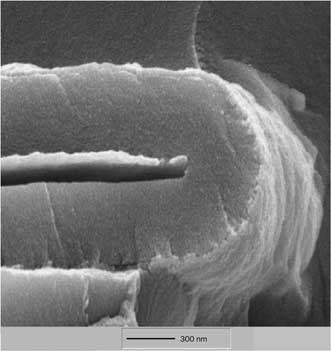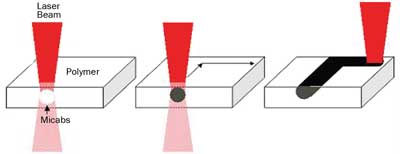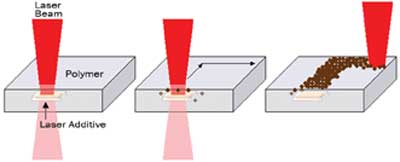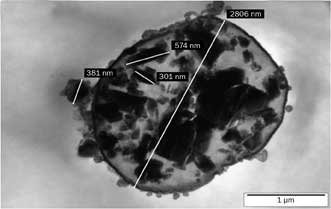Matthew Gailey, EMD Chemicals (an affiliate of Merck KgAA)
The development and refinement of plastics additives or laser sensitivity enable high-contrast marking of plastics in combination with a suitable laser beam. Here’s how to choose the right additives for the job.
Thanks to lasers, manufacturers can write characters and images on any plastic parts you can think of, no matter the shape or surface structure. Expiration dates on bottle closures, serial numbers on technical parts, or marking items with an ID number or even indestructible bar codes – it’s all possible with materials advances and lasers.
The NIR laser is gaining importance and preference when it comes to the marking and coding of plastics. Eco-friendliness, durability, indelibility and flexibility are just a few aspects that give priority to laser marking and coding over other marking techniques. In fact, laser marking is generally accepted as the best way to permanently mark thermoplastics in some industries, such as for animal identification (cattle tags) and security straps.

A typical traditional wavelength-absorbing additive consists of a platelet-shaped mica substrate with
a conductive metal oxide covering.
However, most plastics cannot be marked economically or with adequate results without laser-sensitive additives. By using the correct additive package, a wide variety of polymers in almost any color can be made laser-markable, and the expectations of a high-quality, high-performance polymer will be fulfilled.
Various lasers are available with different active media, setups and optics. All of this will influence the quality of the laser beam and, hence, the variation in the possible settings.
Many commercially available types of solid-state lasers (SSLs) are used in laser marking, each with their own specific characteristics (lamp vs. diode pumped, side vs. end pumped, etc); it is not possible to classify a certain laser as “the best.” When selecting a laser, take into account the laser mark requirements of your specific application, such as contrast, speed and definition.
Finding the right additive for your application means that you must be clear about your requirements. What preconditions do you have? What do you want to achieve?
The polymer has an influence on the color of the mark, while a laser additive enhances the marking result. The laser additive can be seen as a catalyst for marking, so there is a minimum threshold concentration for starting a mark, going up to an optimum concentration. An amount over the optimum does not help to enhance the marking.
The most suitable laser additive and its concentration must be determined on a case-by-case basis. Depending on the additive used and polymer formulation, loadings for these additives can be as low as 0.1 percent by weight in the final part, while more standard loadings are 0.3 to 0.5 percent. The presence of other additives in the formulation – colorants, antioxidants, stabilizers, flame retardants or fillers – can adversely affect the marking results, although the plastics remain markable in most cases. As much as the polymer and the laser marking additive may have an influence, the laser and its optimized settings also determine a good marking result.

In difficult-to-mark plastics, the carbonization is limited to the nylon bead in the Micabs formulation,
eliminating the influence of the surrounding plastic matrix on the quality of the laser mark.
In a single NIR-laser-marked line, we can find a combination of unchanged polymer, carbonized particles and gas bubbles. The composition of the final material is vitally important to attain optimum results. Additives for NIR lasers transform the energy of laser light and, thus, attain a visible color change. We will discuss the two most commonly used NIR additives here: traditional wavelength absorbers and matrix-independent carbonization.
Traditional wavelength absorbers are incorporated into the plastic matrix during processing; they absorb that particular laser wavelength and transform laser light into heat. The heat induces a color-change reaction in the polymer itself, and the pigments are very effective in particular polymers. The advantages of these additives are their high temperature stability and transparency. This type of additive is most commonly found as a powder. Depending on the type of polymer and laser settings, the mark will appear either light or dark.

Traditional wavelength-absorbing additives transform laser light into heat, which then induces a color-change reaction in the polymer. Depending on the type of polymer, the mark will appear either light or dark.
The additives are easy to incorporate into existing formulations; they give well-defined and high-contrast markings even with low laser intensities. To ensure optimal mixing, it is essential that the additives are processed into a master batch or compound prior to being added to the final production step. They demonstrate versatility by being neutral in color – or even transparent – and are cost-effective as a result of their low addition rate.
Matrix-independent carbonization is a granular additive that consists of micron-sized particles, each of which contains both a laser absorber and a color former. These particles are incorporated into a “universal” resin carrier, usually polyethylene (PE), and sold as nondusting plastic concentrate. With this combination, the particles turn dark when exposed to a laser beam. As such, the laser marking performance no longer relies on the color-forming ability of the base polymer in the customer’s formulation. A consistent high-quality mark is achieved regardless of the polymer base. The advantages of these granules are their versatility and suitability for a wide variety of polymers.

Granules consist of a laser absorber and a color former, the two most important components for laser marking. All active ingredients are encapsulated in the polymer matrix at just the right amount for optimum laser-marking performance. The encapsulation minimizes the exposure of the ingredients to operators in production and makes the additive convenient to handle.
The granules enhance the “dark on light” laser-marking performance of most thermoplastics. These additives can be incorporated into master batches with other additives and colors, or they can be added during the final production step of the product. The second option offers flexibility, but the existing carrier system (the PE) must not interfere with the final application. If you require laser marking for many different polymers, this marking material offers you the greatest flexibility in your production.
As mentioned, these granules consist of a laser absorber and a color former, the two most important components for laser marking. All active ingredients are encapsulated in the polymer matrix at just the right amount for an optimum laser marking performance. The encapsulation also minimizes the exposure of the ingredients to operators in production and makes the product itself more convenient to handle because of its concentrated pellet form.
The granules are suitable for a wide range of applications, including animal identification systems such as ear tags, in which the markings must meet strict animal husbandry requirements. Cables and wires can be a challenge to mark; it has been found that these granules achieve a high print consistency with virtually no rejects. Caps and closures are widely used as information carriers, but call for robust and fine-line/high-resolution markings; the additives fill that need. Seals and straps offer improved security and ease of tracking for applications, but require UV stability, and weather and solvent resistance; the granules meet these requirements, too.
The need for track and trace is unavoidable in today’s global market, and requirements for forgery-proof, durable marking are becoming increasingly demanding; e.g., the level of information that must be transferred and the quality of the mark. Miniature codes must be precise and free from defects, and must remain readable under any circumstances.
The advantages of laser marks can be exploited to their full extent only if the polymer, color and additive composition and laser settings are optimally coordinated. As such, although developments with laser manufacturers have made these lasers more readily available and cost effective for production lines, and additive suppliers have made it easier than ever to get contrasting permanent marks on plastics, obtaining a “customer-acceptable mark” is still a cooperation between the laser manufacturer, the additive supplier and the customer working hand in hand to achieve that goal.
Meet the author
Matthew Gailey is the technical manager, Americas, of functional additives at EMD Chemicals in Philadelphia, an affiliate of Merck KGaA of Darmstadt, Germany; email: [email protected]
Advantages of laser marking for plastics:
• Very flexible in terms of surface and design.
• Economical.
• Can be carried out at very high speed and without contact.
• Inkless process.
• Marking difficult to counterfeit.
• Pretreatment of surface not necessary.
• Marking can be miniaturized.
• Marking process can be incorporated in production process.